Yeast for Baking:
Baker’s Yeast, Brewer’s Yeast, Nutritional Yeast, Instant Dry Yeast, Active Dry Yeast, Yeast Cakes, Compressed Yeast, Fast Rise Yeast, Rapid Rise Yeast, Quick Rise, Bread Machine Yeast, Wild Yeast … how are you supposed to know what to use when baking gluten free bread??! And what if you can’t have or don’t have yeast?
Good questions, all! Luckily I have answers for you!
First things first — what is “yeast?” Simply put, yeast is a living micro-organism that converts sugar and starch into carbon dioxide and alcohol, making it the perfect ingredient for beer brewers, wine makers and bread bakers — anywhere you need bubbles.
Yeast can be divided into 4 general categories: Dried Yeast; Fresh Yeast; Wild Yeast; and Brewer’s Yeast.
For basic, at-home gluten-free bread baking purposes, we’re sticking with the first category, but in case you are curious, I’ll give you the nutshell version of the other three kinds of yeast (it’s great trivia to impress your friends!).
(And in case you’re wondering, the yeasts we’re going to be talking about are all gluten free unless otherwise noted.)
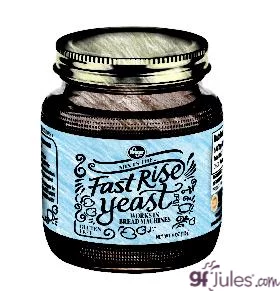
Baker’s/Dried Yeast:
This form of Baker’s yeast is alive but inactive due to lack of moisture.
Quick Rise, Rapid Rise, Fast Rise, Instant Dry and Bread Machine Yeast
These type of yeast are all basically the same, but are different from “Active Dry Yeast” in that they are more finely granulated and are dried to a lower moisture level, so these quick rise yeasts need not be dissolved in water to become hydrated before mixing (i.e. no proofing!). Specific brand package directions will indicate the amount of time recommended by the manufacturer to allow for rising. Here’s the Quick Rise Yeast I use most often in my gluten free baking.
What does the name mean to you? It means that these instant dry yeasts can be added to the dry ingredients during mixing or can be added last, on top of other dry ingredients in a bread machine. Furthermore, these fast rise yeasts usually contain ascorbic acid which increases the height you’ll achieve with most baked loaves.
Gluten free loaves do not need — and in fact, should not be punched down and given a second rise (find out why in this article) — so these instant yeasts are the perfect choice for your gluten free bread baking needs. Do not proof these yeasts or they will lose some of their fast rising properties. Click here for the Quick Rise Yeast I prefer for my gluten free baking.
Active Dry Yeast
This type of yeast has larger granules and must be dissolved completely for the yeast to become “active,” so it must be dissolved in warm water (100° to 110°F) before using. This process is called “proofing” or “proving” the yeast.
It also typically requires more Active Dry yeast to rise a bread loaf than it does Instant Yeast, so those recipes can smell and taste more “yeasty.”
If a recipe calls for Quick Rise or Rapid Rise Yeast, can I use regular Active Dry Yeast instead? Yes! Here’s How:
If a recipe calls for Quick Rise yeast and you’re using Active Dry yeast instead, use 1 1/4 x more Active Dry yeast than the Quick Dry yeast called for in the recipe. (Example: recipe calls for 2 1/4 tsp Quick Rise yeast; use 2 3/4 tsp Active Dry yeast.) You also must proof the yeast before adding it to the recipe.
Dried yeast of either kind is most often sold in 3-pack strips or in 4-ounce jars. Three-pack strips each contain a 2 1/4 tsp. of yeast per packet — the amount typically required for one loaf of bread. The 3-packs also help to keep yeast fresh if you’re not using it daily.
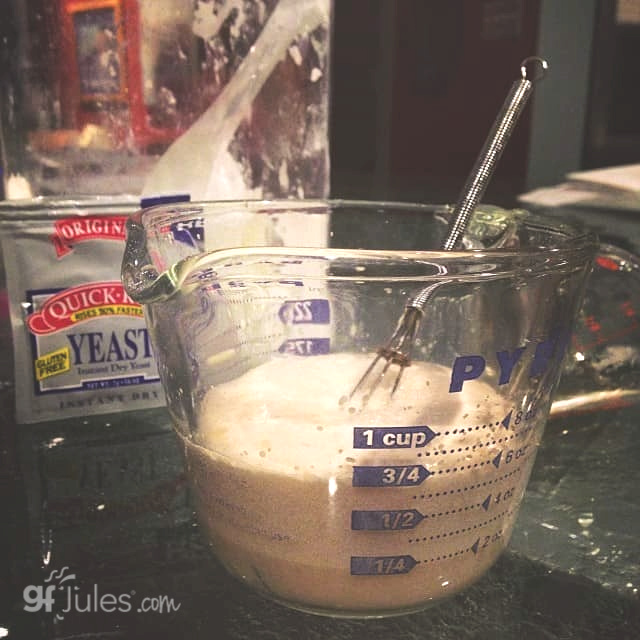
To proof active dry yeast or cake yeast …
add 1 packet of yeast plus 1/4 cup warm water and 1 teaspoon sugar. By warm water, I mean 100-110F, or an easy trick is just to stick your finger in the water and if it feels a little warm, it’s probably just right. Cold water won’t activate the yeast well and if the water is too hot, it could kill the yeast organisms. Think Goldilocks — it needs to be just right!
Stir the mixture together in a bowl like pictured here and let it sit for 5-10 minutes. The yeast should start bubbling, which means it is fermenting into alcohol and carbon dioxide — the bubbles you want inside your breads to give them rise and lightness.
Always store yeast away from moisture and at room temperature, and use by the expiration date; it does keep longer if refrigerated or frozen, but bring it to room temperature before using. Almost all of these types and brands (Red Star; SAF, Hodgson Mill, Fleishmann’s, …) of yeast are gluten free and many say so on the packaging. Here’s a link to buy gluten free Active Dry Yeast.
NOTE: Red Star PLATINUM and Red Star SOURDOUGH STARTER are NOT GLUTEN FREE. As with anything else, always read labels!
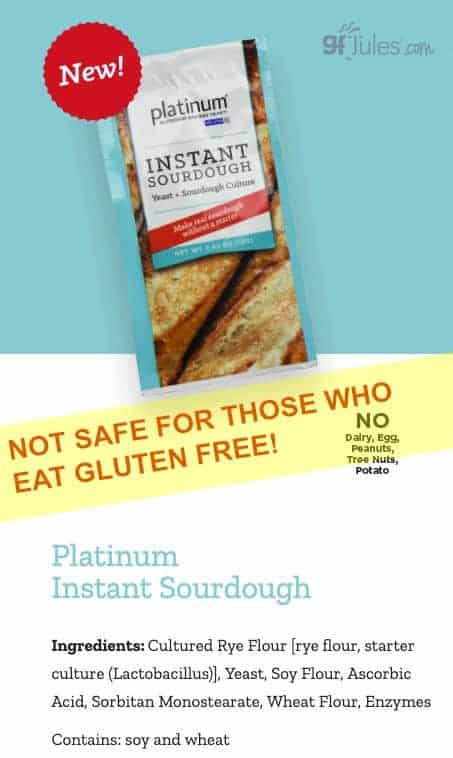
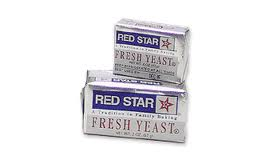 Baker’s/Fresh Yeast:
Baker’s/Fresh Yeast:
This yeast (also called “Cake Yeast”) is alive and extremely perishable since it has not been dried. You may, but you don’t have to, proof this yeast. To work with fresh yeast, soften the yeast cake in warm water or just crumble it into the dry ingredients.
Fresh yeast requires two rises, so it is not ideal for gluten free breads, which require only one rise. To substitute fresh yeast in a recipe calling for active dry yeast, use one cake for each package (2 1/4 teaspoons) of Active Dry or Instant Yeast called for in the recipe.
Wild Yeast:
Ever made a sourdough starter? That’s Wild Yeast. Starters are comprised of a mixture of equal parts flour and water, “colonized” by yeast and friendly bacteria (and yes, you can make a gluten free sourdough starter — use my gfJules Multigrain Flour or All Purpose Flour!).
One way of making your own starter is to simply sprinkle 2-3 teaspoons of rapid rise or active dry yeast onto 2 cups of warm water and let sit for 15 minutes, then whisk in 2 cups of gluten free all purpose flour. Cover loosely, and let the mixture sit. You need to “feed” it, as my friend Amy says – “like a pet!”
The more authentic way of making sourdough starter is to follow the recipe below by mixing in a non-reactive container like glass, glazed pottery, stainless steel, or food-grade plastic.
Go HERE for Gluten Free Sourdough Starter Recipe
Gluten Free Sourdough Bread Recipe
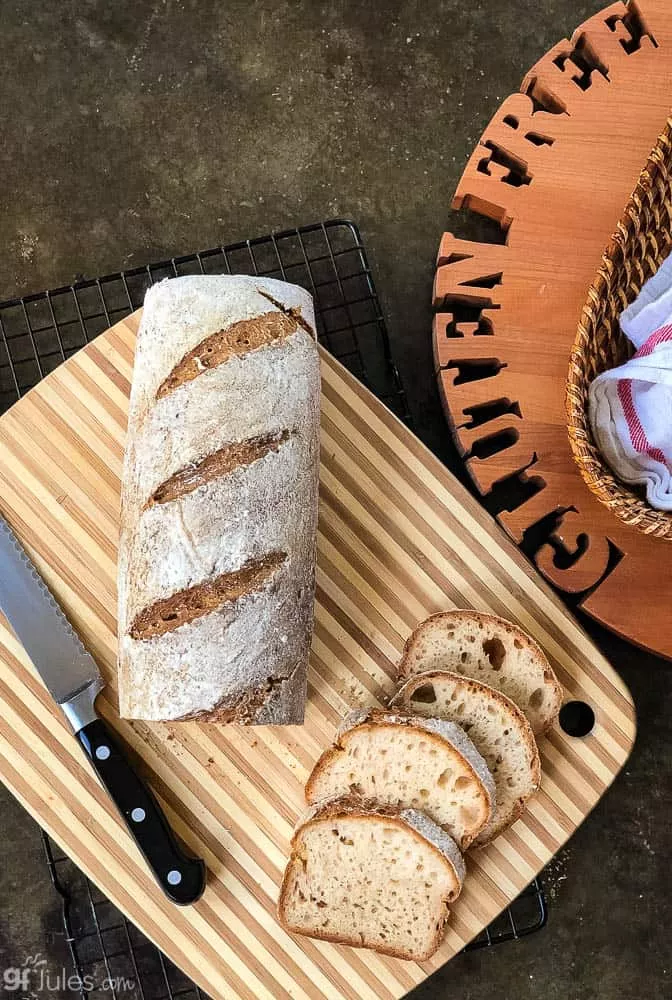
Brewer’s Yeast/Nutritional Yeast:
To confuse things further, there are two kinds of Brewer’s Yeasts: one used to produce alcohol and bubbles in beer; the other used as a nutritional supplement. The latter is what is used in cooking — it is deactivated, and will not produce any alcohol or bubbles, and thus, will not rise your bread.
While there is a difference between the Brewer’s Yeast used for cooking and Nutritional Yeast, they are actually made from the same strain of yeast. Brewer’s Yeast for cooking is a by-product of beer production and thus, retains some of the bitter flavor from the hops; Nutritional Yeast is not as bitter because it is grown on molasses.
One would assume that people eating gluten free would need to avoid “Brewer’s” yeast, opting for “Nutritional” yeast instead; however, one brand I have used takes confusion to new heights by calling itself “Brewer’s Yeast: High Potency Instant Natural Nutritional Yeast.”
At first, I passed it by, but the product rep assured me it was gluten free (it’s also certified gluten free). How could this be? Apparently because this particular “Brewer’s Yeast” product is grown on beet molasses, rather than being a by-product of gluten containing beer processing. Right. I wish they could get their terminology straight! (Yet another reason to read labels thoroughly in every case!) {Bragg Gluten Free Nutritional Yeast}
As a nutritional supplement, this yeast offers a cheesy/nutty flavor that vegans love to use in recipes where the cheese is not used — it’s even great on popcorn! It is also full of protein and B vitamins, and thus is highly prized, particularly in the vegetarian community.
I have a great recipe for gluten free crustless (vegan) quiche in my newest cookbook, Free for All Cooking. I also use it in some other savory gluten free dinner recipes in my Gluten Free Dinner-A-Day ebook. It’s fun to make something so simple and easy for your family’s dinner, and know it’s chock full of yummy good-for-you goodness — you really should give nutritional yeast a try in some of your recipes, too!
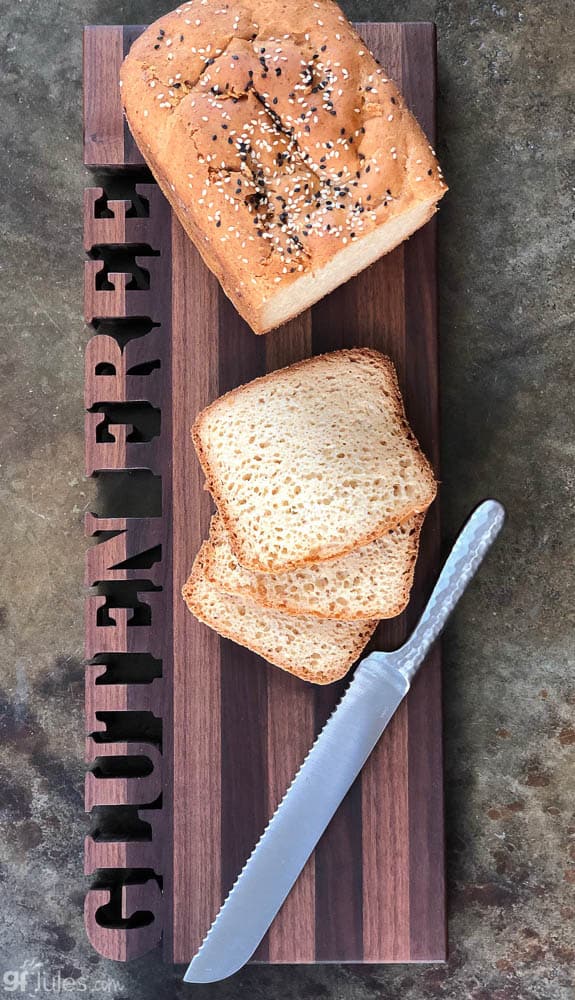

Gluten Free Bread Baking — which yeast and why?
So by now you’re probably asking why gluten free yeast breads require only one rise, and therefore work well with the instant yeast varieties.
Well, we have come to the point in this program where we can celebrate the fact that gluten free yeast breads are actually faster to make and to bake because they do not contain gluten. Obvious, I know, but that means that there is no “punch down” step, no second rise, and no kneading required. In fact, all those steps are done just to “exercise” the gluten, which is totally lacking in our breads (right?!).
So actually, not only do you not need to take those steps, you don’t want to do them either, or you will kill your precious gluten free bread! For more on they why and how of making great gluten free bread … easily, read my top tips to Great Gluten Free Bread.
Trust me: when making gluten free bread, simply mix/beat well; cover & rise; bake; enjoy. That’s it. Easy as can be. You can even do it with a wooden spoon and bowl, although I’ll admit I use my stand mixer every time I have a choice. Check out my updated Gluten Free Bread Baking ebook for loads more gluten free bread baking tips and 32 gluten free bread recipes!

What if I can’t have yeast or can’t find yeast?
I have lots of gluten free bread recipes that don’t require yeast.
Many breads can still be yummy when you use chemical leaveners like baking soda and baking powder in place of yeast. Typically you’ll use the same amount of double acting baking powder in place of yeast, so if a recipe calls for one packet of yeast, you’ll use 2 1/4 teaspoons of baking powder.
If you don’t have baking powder, you’ll need to add baking soda plus an acid, so use an equal amount of baking soda and lemon juice or white vinegar in place of yeast. Either double acting baking powder or the baking soda + acid trick will replace the yeast needed to create the bubbles that give the dough lift and create air pockets that make bread, well, bread. What will be different is that there will be no yeasty smell or taste and there will be no need to allow for rise time.
Yeast-Free Gluten Free Bread recipes:
- Gluten Free Yeast Free Sandwich Bread Recipe
- Gluten Free Yeast Free Pizza Recipe (Scroll to the bottom for yeast-free modification)
- Gluten Free Yeast Free Dinner Rolls Recipe
- Gluten Free Flour Tortillas Recipe
- Gluten Free Pita Bread or Flatbreads Recipe
- Gluten Free Sourdough Breadsticks Recipe
- 52-Minute Gluten Free Cinnamon Bun Recipe
- Gluten Free Irish Soda Bread Recipe
- Grain-Free & Yeast-Free Bagels Recipe
These yeast-free, gluten-free bread recipes are fantastic, and prove that you don’t need yeast to make great bread. I encourage you to give these recipes a try.
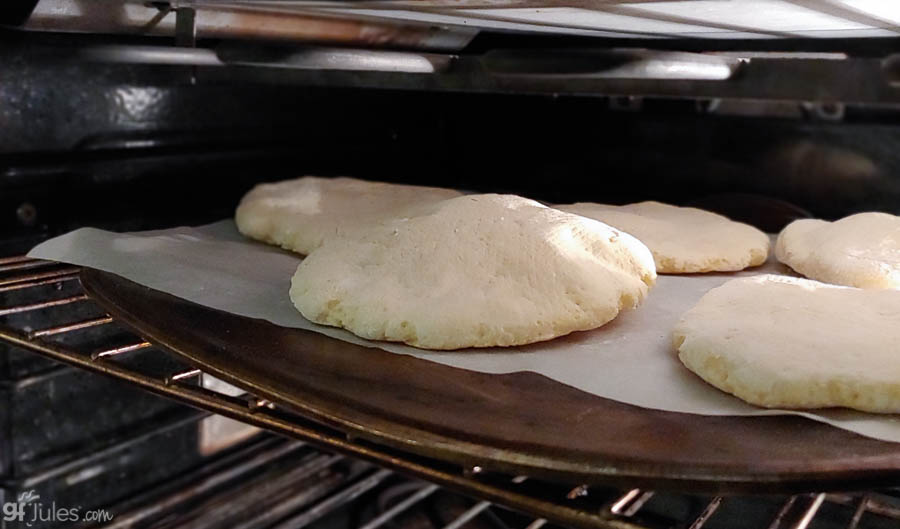
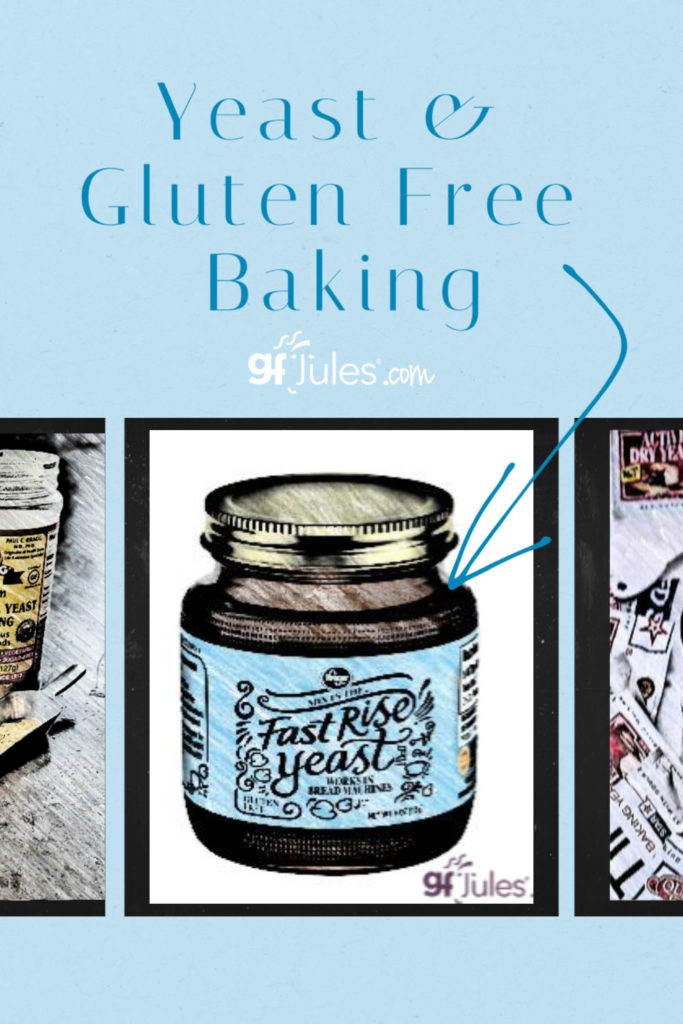
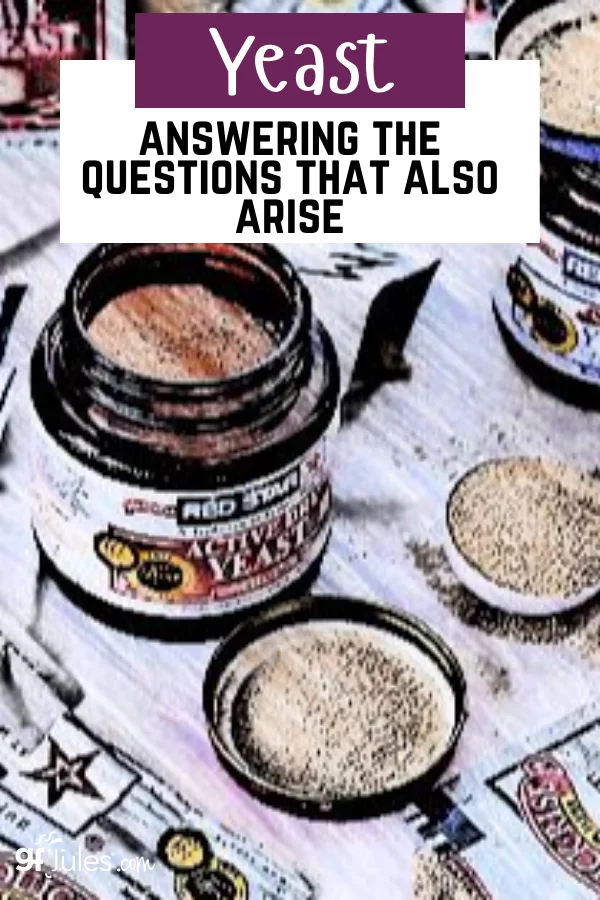
*In some cases, sponsors have provided free product. Some links to products may be affiliate links; purchasing through these links doesn’t cost you anything additional. As always, all opinions are my own. See my disclosure policy for more information. Working with select brands I love allows me to keep bringing you free recipes and great contests! I hope that in the process, you’ll learn about some of the safe gluten free products I choose for my family. Thanks so much for your support!
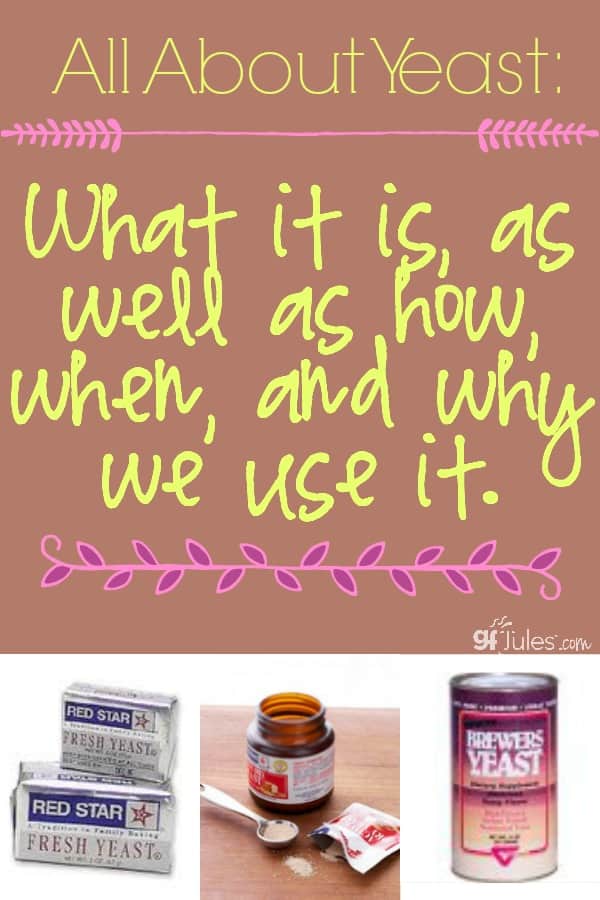


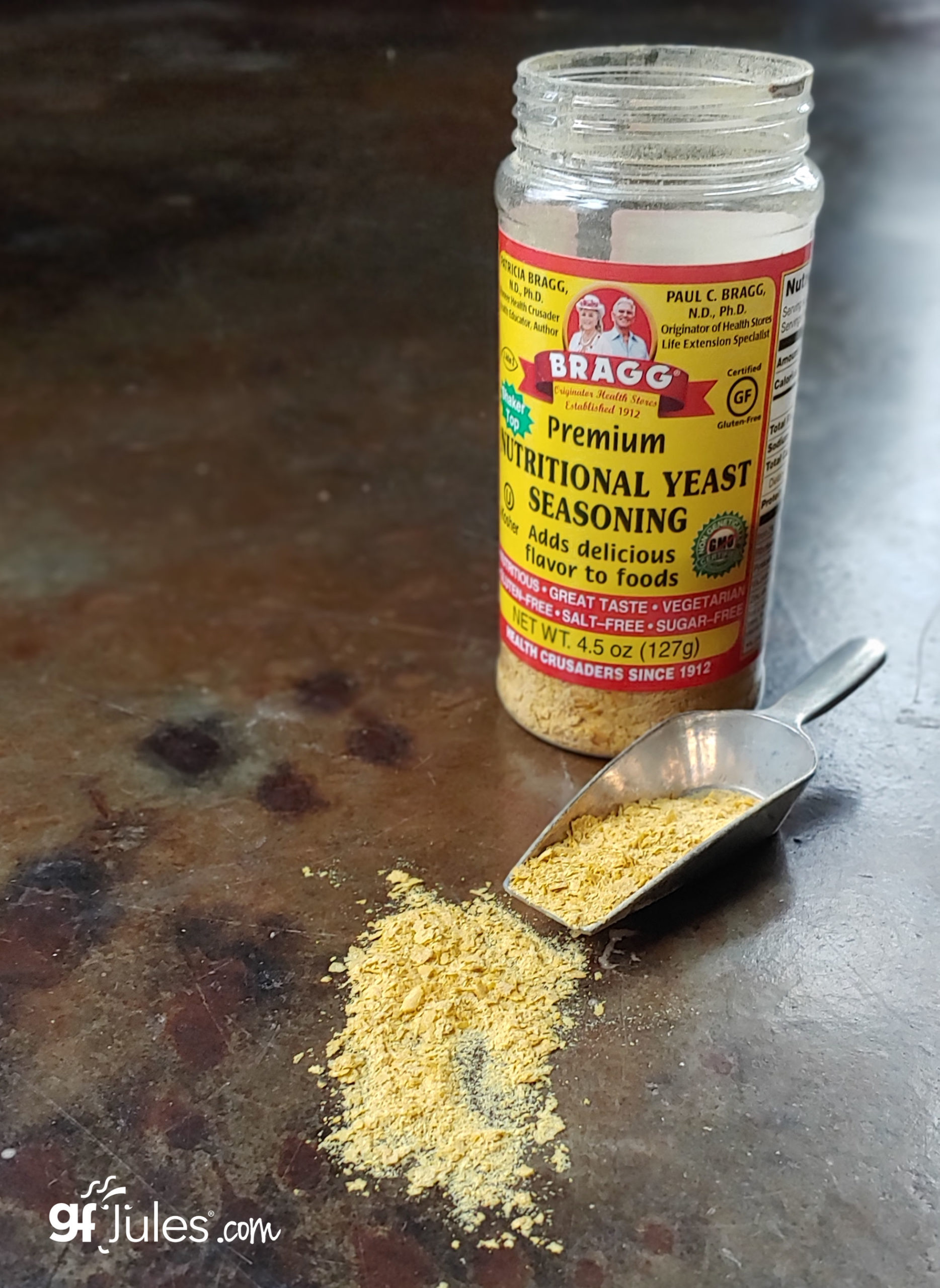



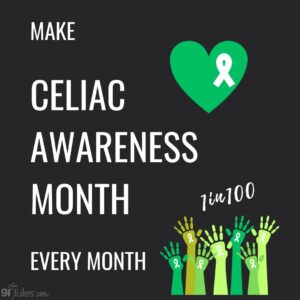













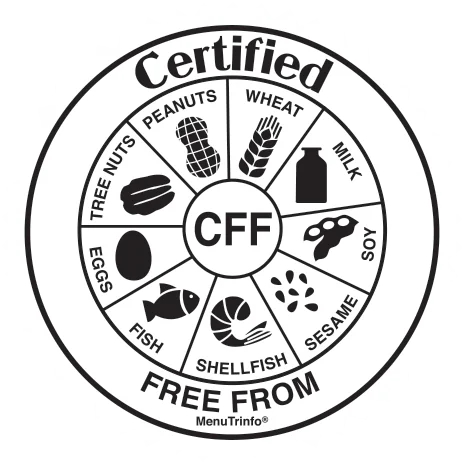
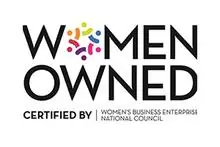

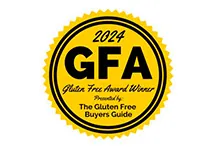
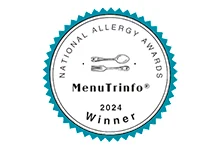
If I only have instant yeast can I use it in place of rapid rise yeast in your recipe for GF sandwich bread?
Hi Janet, yes you can use regular yeast in place of quick rise yeast, just follow the instructions to proof the yeast first and you may want to allow it to rise longer as well.
~jules
OMG ,
I was looking for yeast answers and I thought your site was Girl Friend Jules. And as I was reading this page I kept thinking, “wow someone’s girlfriend really does not like gluten.” I must have said that to myself 4 or 5 times before I figured out what GF stands for.
Lol I am so goofy.
Ok that’s about the funniest thing I’ve heard all week! Thank you for not keeping that to yourself!!!! LOL!
~jules
Hello,
I have a yeast question:
I few months ago I gained access to a bunch of free local raw honey, and I started making up some mead. I have been expierementing by mixing different strains of brewers yeasts together as I rehydrate them. Will they compete to produce more alcohol? Will they compete and kill each other off? Will they reproduce and make a hybrid strain? Will they do their own things separately? I have no idea what is happening. Also I have been pumping the carbondioxide from my brewing station into my indoor greenhouse. I am finding small white hairs on my soil around the inlet to the growth chamber. Did I give my plants a yeast infection? If so how can I keep the C02 but loose the yeast on the trip from fermentiontation airlock to growth chamber?
Have you ever made Pizzelles with Jules Flour. I have had probelems with very flour brand. The Pizzelles stick, even though it is a Teflon iron and I treat it with oil as directed.
How long is solid cake yeast good for? I want to bake in Dec. our stor runs out of it quickly in December!
Hi Pamela, cake yeast should last 1-2 weeks in a pantry or 2-3 weeks in the fridge. Happy baking!
~jules
Hi
I am trying to make gluten free bread but it does not rise. It tastes Ok but is only about 6 cm in height, very dense and SOLID! Iv’e read that it could be that the instant yeast I am using is not as good in gluten free baking as Dry Active Yeast? what is your opinion? does this make a difference. I cannot get hold of Dry Active Yeast to even try it.
Hi Angie -a few questions. First, what recipe are you using? What kinds of gluten free flours? And what yeast are you using if no dry active or quick rise yeast?
Happy to help, I just need more information.
~jules
Hi Jules, Do you have a sourdough starter recipe? There are so many out there, but I would like to use your flour mix, without yeast and am not sure which recipe to follow with success.
Hi Randi – great question! It’s on my very long “to do” list! Luckily, though, I’ve had readers write to me and share their recipes using my flour. Here’s a recent one from Davida S.: “For the starter I used 1/2 C of your Jules GF flour, plus 1/2 C of bottled water. To this mixture I added 6 grapes that were peeled and halved. I “fed” the mixture twice a day with 1/4 C of both flour and water. In 2-3 days, the mixture started to bubble, so I removed the grapes. BTW, it’s important to use a glass jar with a piece of cloth in place of a lid (to collect natural yeast from the air). I rolled it out thinly, then used a 4-inch round cutter. After letting them rise, I baked them at 375 for a shorter period of time. I don’t have the exact time down yet, nor the exact thickness. But they were so nice for sandwiches–both open-faced and double-sided. Thanks for the great flour.:
I hope that helps, Randi! Let me know how it goes!
It’s just I thought Coeliac weren’t allowed wheat
Hi, i bought dry yeast today to make a gluten free loaf,but it says contains wheat. Is it ok to use this??
If you are living gluten-free, don’t eat anything that says it contains wheat. Most yeast is totally fine for celiacs and those with gluten sensitivity, but if the manufacturer is telling you it contains wheat, don’t use it!
I some how missed it, but in the last paragraph, you say, “By now you are probably wondering which yeast is gluten free?” But you didn’t actually answer your own question. Which one? You make it kind of confusing when you talk about them. It almost seems like you are calling them by different names when you talk about one particular kind. I didn’t take the time to read all the other comments. Maybe someone else thought the same way. Maybe someone made the info more clear. Please clear up my confusion!!!
Hi Mary, I’m not sure where you see that unanswered question in the article, but I’m happy to answer it for you. All commercially available yeasts should be gluten-free except brewer’s yeast that is a by-product of actual beer brewing. Fleischman’s and Red Star yeasts — the ones you are most likely to find at your grocery store — are even labeled as gluten-free. I hope that clears things up for you.
Jules I gave in and went with a simple recipe I found online that didn’t require mixing, kneading, or rising. It is from white rice flour but out of all the simple ingreadents it did call for milk. I have allergies to milk so I substituited it with soy milk. I failed to notice that the whole recipe only fills a SMALL tin, whatever that means, I used a standard loaf size. So I went ahead and baked what I made and it came out great. It was more like cornbread however but I’m not complaining. I’m going to have to tripple the recipe to fill my pan next time but I’m only unsure how long to bake it for.
The color was more like cornbread, and so was the taste. I also have allergies to yeast and lucked out because this recipe has none. This is probably why there was no rise stage. It was perfect and spongy like bread anyhow, it got eaten up by everyone fast. Any suggestions?
Hi Lawrence, send an email to Support@JulesGlutenFree.com and they’ll send you my yeast-free bread recipe that I think you will really like. It makes a whole loaf. It’s in my cookbook, Free for All Cooking, but it’s not on my blog.